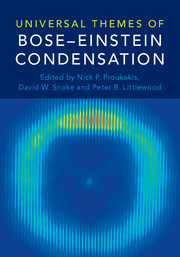Book contents
- Frontmatter
- Contents
- Foreword
- Preface
- Part I Introduction
- Part II General Topics
- Part III Condensates in Atomic Physics
- Editorial Notes
- 13 Probing and Controlling Strongly Correlated Quantum Many-Body Systems Using Ultracold Quantum Gases
- 14 Preparing and Probing Chern Bands with Cold Atoms
- 15 Bose-Einstein Condensates in Artificial Gauge Fields
- 16 Second Sound in Ultracold Atomic Gases
- 17 Quantum Turbulence in Atomic Bose-Einstein Condensates
- 18 Spinor-Dipolar Aspects of Bose-Einstein Condensation
- Part IV Condensates in Condensed Matter Physics
- Part V Condensates in Astrophysics and Cosmology
- Universal Bose-Einstein Condensation Workshop
- Contributors
- Index
- References
13 - Probing and Controlling Strongly Correlated Quantum Many-Body Systems Using Ultracold Quantum Gases
from Part III - Condensates in Atomic Physics
Published online by Cambridge University Press: 18 May 2017
- Frontmatter
- Contents
- Foreword
- Preface
- Part I Introduction
- Part II General Topics
- Part III Condensates in Atomic Physics
- Editorial Notes
- 13 Probing and Controlling Strongly Correlated Quantum Many-Body Systems Using Ultracold Quantum Gases
- 14 Preparing and Probing Chern Bands with Cold Atoms
- 15 Bose-Einstein Condensates in Artificial Gauge Fields
- 16 Second Sound in Ultracold Atomic Gases
- 17 Quantum Turbulence in Atomic Bose-Einstein Condensates
- 18 Spinor-Dipolar Aspects of Bose-Einstein Condensation
- Part IV Condensates in Condensed Matter Physics
- Part V Condensates in Astrophysics and Cosmology
- Universal Bose-Einstein Condensation Workshop
- Contributors
- Index
- References
Summary
Ultracold atoms in optical lattices provide an extremely clean and controllable setting to explore quantum many-body phases of matter. Here we give a brief review of the strong-correlation physics that has been realized using such ultracold atoms in optical lattices ranging from the realization of Hubbard models to studies of quantum magnetism and the detection of single atoms with lattice site resolution. All this has opened up fundamentally new opportunities for the investigation of quantum many-body systems.
Introduction
Over the past years, ultracold atoms in optical lattices have emerged as versatile new systems to explore the physics of quantum many-body systems. On the one hand, they can be helpful in gaining a better understanding of known phases of matter and their dynamical behavior; on the other hand, they allow one to realize completely novel quantum systems that have not been studied before in nature [1, 2, 3]. Commonly, the approach of exploring quantum many-body systems in such a way is referred to as “quantum simulations.” Examples of some of the first strongly interacting many-body phases that have been realized both in lattices and in the continuum include the quantum phase transition from a superfluid to a Mott insulator [4, 5, 6], fermionic Mott insulators [7, 8], the achievement of a Tonks- Girardeau gas [9, 10], and the realization of the Bose-Einsten condensate (BEC)– Bardeen-Cooper-Schrieffer (BCS) crossover (see also Chapter 12) in Fermi gas mixture [11] using Feshbach resonances [12].
In almost all of these experiments, detection was limited to time-of-flight imaging or more refined derived techniques that mainly characterized the momentum distribution of the quantum gas [2]. For several years, researchers in the field have therefore aspired to employ in situ single-particle detection methods for the analysis of ultracold quantum gases. Only recently has it become possible to implement such imaging techniques, marking a milestone for the characterization and manipulation of ultracold quantum gases [13, 14, 15, 16, 17]. In our discussion, we will focus on one of the most successful of these techniques based on high-resolution fluorescence imaging. Despite being a rather new technique, such quantum gas microscopy has already proven to be an enabling technology for probing and manipulating quantum many-body systems. For the first time, controllable and strongly interacting many-body systems, as realized with ultracold atoms, could be observed on a local scale [17, 16].
- Type
- Chapter
- Information
- Universal Themes of Bose-Einstein Condensation , pp. 253 - 273Publisher: Cambridge University PressPrint publication year: 2017

